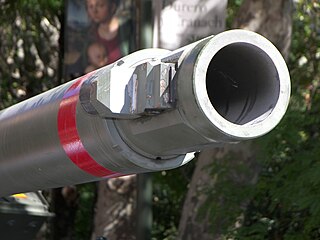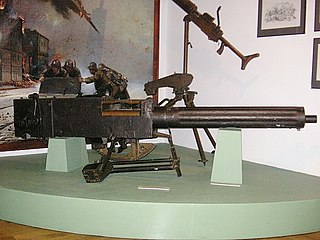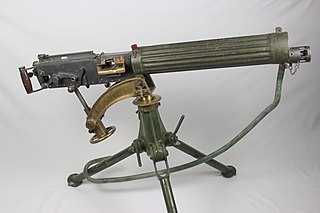 W
WA tank gun is the main armament of a tank. Modern tank guns are large-caliber high-velocity guns, capable of firing kinetic energy penetrators, high explosive anti-tank rounds, and in some cases guided missiles. Anti-aircraft guns can also be mounted to tanks.
 W
WThe 7.5 cm KwK 40 (7.5 cm Kampfwagenkanone 40) was a German 75 mm Second World War era vehicle-mounted gun, used as the primary armament of the German Panzer IV (F2 models onwards) medium tank and the Sturmgeschütz III (F models onwards) and Sturmgeschütz IV tank destroyers/assault guns.
 W
WThe 7.5 cm KwK 42 L/70 was a 7.5 cm calibre German tank gun used on German armoured fighting vehicles in the Second World War. The gun was the armament of the Panther medium tank and two variants of the Jagdpanzer IV self-propelled anti-tank gun. On the latter it was designated as the "7.5 cm Panzerabwehrkanone 42" anti-tank gun.
 W
WThe 8.8 cm KwK 36 was an 88 mm tank gun used by the German Army during World War II. This was the primary armament of the PzKpfw VI Tiger I tank. It was developed and built by Krupp.
 W
WThe 8.8 cm KwK 43 was an 88 mm 71 calibre length tank gun designed by Krupp and used by the German Wehrmacht during the Second World War. It was mounted as the primary armament on the Panzerkampfwagen VI Ausf. B Tiger II. The 8.8 cm Pak 43, an anti-tank gun, was very similar in design but mounted on tank destroyers or deployed stand-alone on the field.
 W
WThe ZiS-2 was a Soviet 57-mm anti-tank gun used during World War II. The ZiS-4 was a version of the gun meant to be installed in tanks. ZiS stands for Zavod imeni Stalina, the official title of Artillery Factory No. 92, which produced the gun first.
 W
WThe Besa machine gun was a British version of the Czechoslovak ZB-53 air-cooled, belt-fed machine gun.
 W
WThe Mitragliatrice Breda calibro 8 modello 38 per carri armati was an Italian tank-pattern machine gun used in the Second World War on the Fiat L6/40, the Fiat M11/39 and the Fiat M13/40. It was also adapted as infantry machine gun. The M38 is based upon the Breda M37. The Breda 38 received the German identification code Kampfwagen-Maschinengewehr 350(i).
 W
WThe FV4601 MBT-80 was a British experimental third-generation main battle tank, designed in the late 1970s to replace the Chieftain tank. It was eventually cancelled in favour of the Challenger 1, itself an evolution of the Chieftain design.
 W
WThe Falcon Turret is a low-profile main battle tank turret under development by King Abdullah II Design and Development Bureau in Jordan, with technical assistance from South Africa.
 W
WThe IMI 120 mm gun is an L44 smoothbore tank gun designed and produced by Israeli Military Industries (IMI). It is widely confused as a licensed production of the Rheinmetall L44 tank gun, however it was developed by IMI from 1983 to 1988, to meet the requirements of the Israel Defense Forces' Merkava Mark III main battle tank, i.e. a narrower mount like in the M-60, both tanks designed around a 105mm gun.
 W
WThe Littlejohn adaptor was a device that could be added to the British QF 2 pounder (40 mm) anti-tank gun. It was used to extend the service life of the 2-pounder during the Second World War by converting it to squeeze bore operation. "Littlejohn" came from the calque, i.e. literal anglicization, of the name of František Janeček, the Czech designer and factory owner who had been working on the squeeze-bore principle in the 1930s and his son František Karel Janeček, who had brought his know-how to Britain after fleeing from German-occupied Czechoslovakia.
 W
WThe Ordnance Quick-Firing 6-pounder 7 cwt, or just 6-pounder, was a British 57 mm gun, serving during the Second World War as a primary anti-tank gun of both the British and United States Army. It was also used as the main armament for a number of armoured fighting vehicles.
 W
WThe Ordnance QF Hotchkiss 6 pounder gun Mk I and Mk II or QF 6 pounder 8 cwt were a family of long-lived light 57 mm naval guns introduced in 1885 to defend against new, small and fast vessels such as torpedo boats and later submarines. There were many variants produced, often under license which ranged in length from 40 to 58 calibers, but 40 caliber was the most common version.
 W
WThe Rheinmetall Rh-120 is a 120 mm smoothbore tank gun designed and produced by the West German Rheinmetall-DeTec AG company, developed in response to Soviet advances in armor technology and development of new armored threats. Production began in 1974, with the first version of the gun, known as the L/44 as it was 44 calibers long, used on the German Leopard 2 tank and soon produced under license for the American M1A1 Abrams and other tanks. The 120-millimeter (4.7 in) gun has a length of 5.28 meters (17.3 ft), and the gun system weighs approximately 3,317 kilograms (7,313 lb).
 W
WThe L30A1, officially designated Gun 120 mm Tk L30, is a 120 mm rifled tank gun used by the British Army and Royal Army of Oman. It is fitted in the turret of the Challenger 2 main battle tank. It is an improved production model of the Royal Ordnance L11 series of rifled tank guns.
 W
WThe Type 1 37 mm anti-tank gun was an anti-tank gun developed by the Imperial Japanese Army, and used in combat during World War II. The Type 1 number was designated for the year the gun was accepted, 2601 in the Japanese imperial year calendar, or 1941 in the Gregorian calendar.
 W
WThe Type 1 47 mm anti-tank gun was an anti-tank gun developed by the Imperial Japanese Army, and used in combat during World War II. The Type 1 number was designated for the year the gun was accepted, 2601 in the Japanese imperial year calendar, or 1941 in the Gregorian calendar.
 W
WThe Vickers .50 machine gun, also known as the 'Vickers .50' was similar to the .303 inches (7.70 mm) Vickers machine gun but enlarged to use a larger-calibre 0.5-inch (12.7 mm) round. It saw some use in tanks and other fighting vehicles but was more commonly used as a close-in anti-aircraft weapon on Royal Navy and Allied ships, typically in a four-gun mounting. The Vickers fired British .50 Vickers (12.7×81mm) ammunition, not the better known American .50 BMG (12.7×99mm).
 W
WThe Vickers machine gun or Vickers gun is a name primarily used to refer to the water-cooled .303 British (7.7 mm) machine gun produced by Vickers Limited, originally for the British Army. The machine gun typically required a six- to eight-man team to operate: one fired, one fed the ammunition, the rest helped to carry the weapon, its ammunition, and spare parts. Not to be confused with the Maxim machine gun, it was in service from before the First World War until the 1960s, with air-cooled versions of it on many Allied World War I fighter aircraft.